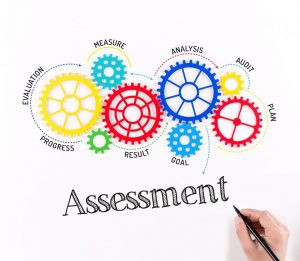What is the triangulation of data…and how the heck do you do master this assessment in the classroom on top of all of the other things you need to do.
What Is It?
The triangulation of data creates a three-prong approach to assessment. This means that all of your assessment does not need to be products. You can assess students in more ways than tests and worksheets.
Assessment can be gathered from three main ways.
- Observations: First all day every day students are doing things that we can observe and track. Assessment can be done through our own observations. When we are working with small groups such as through guided instruction or observing students working independently or in partners. Our observations are a valuable assessment tool to determine student skill levels. Observation is especially important in formative assessment. It helps us as professionals to decide what students can do and where we need to go next. It is a great tool to help us inform instruction.
- Conversations: We should probably talk to our students….right?!? These conversations provide an insight into a student’s level of understanding. Not every student will competently be able to show the depth of their learning through pencil and paper tasks. If our only assessment tool is one method we may miss discrepancies in understanding. Talking to our students and allowing them to explain their thinking and show their learning through these conversations helps to validate our assessment.
- Product: This assessment tool is familiar to most. It’s relatively easy to administer and collect. The teacher hands out a task and the students complete. Then the teacher takes it and marks it on their own time and hands it back. This is probably the most familiar way that teachers use to assess students. However alone this method does not capture a differentiated picture of student learning.
So the challenge becomes how do we add observations and conversations into our program as valid ways to assess student understanding while also understanding the practical ways that make this doable in a busy teacher’s schedule.
How I Use It?
Look for Lists
These are class lists that I determine a set of observable skills I am looking for. In math, these could be “can students accurately model a 5 digit number” and “can they model these numbers in different ways using manipulatives.”
While students are working on this activity…
- I can walk around and watch them do this activity.
- There is also an activity that they can do at a small group table in front of me.
- I assign them to take a video or picture of them doing this and share it with me. Then on my list, I check off using a 1, 2, 3, 4.
Use Some Tech
- Explain Everything: allows you to record, annotate, and capture learning in a very flexible app for Ipads. This allows students to tell you and show you what they have done and what they have learned. They can then share this learning with you and you can mark this just like you would a regular pencil and paper task.
- Flipgrid: is a new tool for me and one I hope to implement more in my classroom. The promise for this app (because I have not used it yet) is the ability to ask a question and students will respond with a selfie video or other video. It also allows students to share their own ideas with each other contributing to the collective understanding of the topic as a group.
- Native Apps and Google Classroom: It’s not a fancy app but simply using the native camera on the iPad or device and recording what they are doing, taking pictures and app smashing their ideas together and often even adding these to slides is a great and easy way to capture learning. Once they have used the apps already installed like camera, voice memo and video editing they can add these to google classroom to share.
- Record Video and Take Pictures: It’s hard to see and hear everything. So sometimes it’s okay to capture understanding and learning by taking video as evidence of learning. This is a record of observations that you can take with you and assess.
Small-Group Learning
This is a great time to be having conversations and observing students. Since we don’t assess modelled or shared lessons for assessment and evaluation we need other opportunities.
Some of my most valuable assessments are made during small group learning. You have a small group where you can watch observe and talk to these students about what they are doing. Look for key skills of students while working with them as areas of focus during this time.
Many of these strategies are what we would encourage a student with an LD or other special education needs to use. However, what is good for one student is probably good for many. Just because you don’t use a test does not mean that your assessment isn’t valid. Also just because parents don’t understand this doesn’t mean that you are not doing the right thing. You don’t have to please the parents…just educate them on what you are doing.
How do you use the triangulation of data to collect assessment information on your students?
Want to hear more from Patti? Check out her blog or find her on Facebook and Instagram!